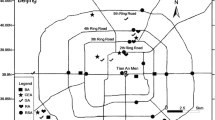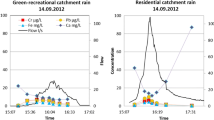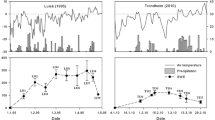Abstract
Stormwater results from precipitation events and melting snow running off urban landscapes and typically being released into receiving water bodies with little to no treatment. Despite evidence of its deleterious impacts, snowmelt (SM) management and treatment are limited, partly due to a lack of quality and loading data. This study examines snowmelt quality during the spring for a cold climate, semi-arid Canadian city (Saskatoon, Saskatchewan). Four snow storage facilities receiving urban snow plowed from roads in mixed land use urban catchments (228 km2) were sampled including snow piles (five events) and SM (twelve events) runoff in 2019 and 2020. Samples were analyzed for pH, EC, TDS, TSS, COD, DOC, metals, chloride, PAHs, and Raphidocelis subcapitata and Vibrio fischeri toxicity. Notable event-specific TSS spikes occurred on April 13, 2019 (3,513 mg/L), and April 24, 2019 (3,838 mg/L), and TDS, chloride, and manganese on March 26, 2020 (15,000 mg/L, 5,800 mg/L, 574 mg/L), April 17, 2020 (5,200 mg/L, 2,600 mg/L, 882 mg/L), and April 23, 2020 (5,110 mg/L, 2,900 mg/L, 919 mg/L), though chloride remained elevated through May 1, 2020, samples (1,000 mg/L). Additionally, at two sites sampled April 13, 2019, pulses of aluminum (401 mg/L) and PAHs (pyrene, phenanthrene, anthracene; 71 µg/L, 317 µg/L, 182 µg/L) were detected. Concentrations of fluorene, benzo[a]pyrene, pyrene, phenanthrene, and anthracene in almost all SP samples exceeded national aquatic toxicity guideline thresholds, while 50% of SM samples exceeded guideline thresholds for benzo[a]pyrene and pyrene, and almost all exceeded the threshold for anthracene. Nevertheless, the EC50 for R. subcapitata and V. fischeri was observed, if at all, above expected toxicity thresholds.



Similar content being viewed by others
Availability of data and materials
Not applicable.
References
Al Masum A, Bettman N, Read S, Hecker M, Brinkmann M, McPhedran K (2021) Urban stormwater runoff pollutant loadings: GIS land use classification vs. sample-based predictions. Submitted to Environ Sci Pollut Res ESPR-D-21–12380
Albert MR, Hardy JP (1995) Ventilation experiments in a seasonal snow cover. Biogeochem Seas snow-covered catchments. Proc Symp Bould 1995:41–49
Aryal R, Vigneswaran S, Kandasamy J, Naidu R (2010) Urban stormwater quality and treatment. Korean J Chem Eng 27:1343–1359. https://doi.org/10.1007/s11814-010-0387-0
Babich H, Stotzky G (1978) Toxicity of zinc to fungi, bacteria, and coliphages: influence of chloride ions. Appl Environ Microbiol 36:906–914
Bäckström M, Karlsson S, Bäckman L, Folkeson L, Lind B (2004) Mobilisation of heavy metals by deicing salts in a roadside environment. Water Res 38:720–732. https://doi.org/10.1016/j.watres.2003.11.006
Barbosa AE, Fernandes JN, David LM (2012) Key issues for sustainable urban stormwater management. Water Res 46:6787–6798. https://doi.org/10.1016/j.watres.2012.05.029
Bartlett AJ, Rochfort Q, Brown LR, Marsalek J (2012) Causes of toxicity to Hyalella azteca in a stormwater management facility receiving highway runoff and snowmelt. Part I: Polycyclic aromatic hydrocarbons and metals. Sci Total Environ 414:227–237. https://doi.org/10.1016/j.scitotenv.2011.11.041
Blecken GT, Rentz R, Malmgren C, Öhlander B, Viklander M (2012) Stormwater impact on urban waterways in a cold climate: variations in sediment metal concentrations due to untreated snowmelt discharge. J Soils Sediments 12:758–773. https://doi.org/10.1007/s11368-012-0484-2
Bossuyt BTA, Janssen CR (2005) Copper regulation and homeostasis of Daphnia magna and Pseudokirchneriella subcapitata: influence of acclimation. Environ Pollut 136:135–144. https://doi.org/10.1016/j.envpol.2004.11.024
Brix KV, Keithly J, Santore RC, DeForest DK, Tobiason S (2010) Ecological risk assessment of zinc from stormwater runoff to an aquatic ecosystem. Sci Total Environ 408:1824–1832. https://doi.org/10.1016/j.scitotenv.2009.12.004
Calonne N, Flin F, Morin S, Lesaffre B, Du Roscoat SR, Geindreau C (2011) Numerical and experimental investigations of the effective thermal conductivity of snow. Geophys Res Lett 38:1–21. https://doi.org/10.1029/2011GL049234
Calonne N, Geindreau C, Flin F, Morin S, Lesaffre B, Rolland D, Roscoat S, Charrier P (2012) 3-D image-based numerical computations of snow permeability: links to specific surface area, density, and microstructural anisotropy. Cryosphere 6:939–951. https://doi.org/10.5194/tc-6-939-2012
Challis JK, Popick H, Prajapati S, Harder P, Giesy JP, McPhedran K, Brinkmann (2021) Occurrences of tire rubber-derived contaminants in cold-climate urban runoff. Environ Sci Technol Lett. https://doi.org/10.1021/acs.estlett.1c00682
Chung JY, Do YuS, Hong YS (2014) Environmental source of arsenic exposure. J Prev Med Public Heal 47:253–257. https://doi.org/10.3961/jpmph.14.036
Codling G, Yuan H, Jones PD, Giesy JP, Hecker M (2020) Metals and PFAS in stormwater and surface runoff in a semi-arid Canadian city subject to large variations in temperature among seasons. Environ Sci Pollut Res 27:18232–18241. https://doi.org/10.1007/s11356-020-08070-2
Cook SV, Chu A, Goodman RH (2000) Influence of salinity on Vibrio fischeri and lux-modified Pseudomonas fluorescens toxicity bioassays. Environ Toxicol Chem 19:2474–2477. https://doi.org/10.1002/etc.5620191012
Ebner PP, Schneebeli M, Steinfeld A (2016) Metamorphism during temperature gradient with undersaturated advective airflow in a snow sample. Cryosphere 10:791–797. https://doi.org/10.5194/tc-10-791-2016
Environment Canada (1993) Biological test method. Toxicity test using luminescent bacteria
EPA (Institution/Organization) (2002) Method 1003.0: Green Alga, Selenastrum capricornutum, Growth Test; Chronic Toxicity
Exall K, Marsalek J, Rochfort Q, Kydd S (2011a) Chloride transport and related processes at a municipal snow storage and disposal site. Water Qual Res J Canada 46:148–156. https://doi.org/10.2166/wqrjc.2011.023
Exall K, Rochfort Q, Marsalek J (2011b) Measurement of cyanide in urban snowmelt and runoff. Water Qual Res J Canada 46:137–147. https://doi.org/10.2166/wqrjc.2011.022
Fulladosa E, Murat JC, Martínez M, Villaescusa I (2005a) Patterns of metals and arsenic poisoning in Vibrio fischeri bacteria. Chemosphere 60:43–48. https://doi.org/10.1016/j.chemosphere.2004.12.026
Fulladosa E, Murat JC, Villaescusa I (2005b) Study on the toxicity of binary equitoxic mixtures of metals using the luminescent bacteria Vibrio fischeri as a biological target. Chemosphere 58:551–557. https://doi.org/10.1016/j.chemosphere.2004.08.007
Galfi H, Österlund H, Marsalek J, Viklander M (2017) Mineral and anthropogenic indicator inorganics in urban stormwater and snowmelt runoff: sources and mobility patterns. Water Air Soil Pollut 228. https://doi.org/10.1007/s11270-017-3438-x
Glen DW, Sansalone JJ (2002) Accretion and partitioning of heavy metals associated with snow exposed to urban traffic and winter storm maintenance activities. II. J Environ Eng 128:167–185. https://doi.org/10.1061/(ASCE)0733-9372(2002)128:2(167)
HACH (2014) Chemical oxygen demand, dichromate method. Hach DOC316.53.:https://doi.org/10.1002/9780470114735.hawley03365
Hautala EL, Rekilä R, Tarhanen J, Ruuskanen J (1995) Deposition of motor vehicle emissions and winter maintenance along roadside assessed by snow analyses. Environ Pollut 87:45–49. https://doi.org/10.1016/S0269-7491(99)80006-2
Helmreich B, Hilliges R, Schriewer A, Horn H (2010) Runoff pollutants of a highly trafficked urban road - correlation analysis and seasonal influences. Chemosphere 80:991–997. https://doi.org/10.1016/j.chemosphere.2010.05.037
Herngren L, Goonetilleke A, Ayoko GA, Mostert MMM (2010) Distribution of polycyclic aromatic hydrocarbons in urban stormwater in Queensland, Australia. Environ Pollut 158:2848–2856. https://doi.org/10.1016/j.envpol.2010.06.015
Hintz WD, Relyea RA (2017) Impacts of road deicing salts on the early-life growth and development of a stream salmonid: salt type matters. Environ Pollut 223:409–415. https://doi.org/10.1016/j.envpol.2017.01.040
Hopkins GR, French SS, Brodie ED (2013) Increased frequency and severity of developmental deformities in rough-skinned newt (Taricha granulosa) embryos exposed to road deicing salts (NaCl & MgCl2). Environ Pollut 173:264–269. https://doi.org/10.1016/j.envpol.2012.10.002
Howitt JA, Mondon J, Mitchell BD, Kidd T, Eshelman B (2014) Urban stormwater inputs to an adapted coastal wetland: role in water treatment and impacts on wetland biota. Sci Total Environ 485–486:534–544. https://doi.org/10.1016/j.scitotenv.2014.03.101
Huang J, Du P, Ao C, Ho M, Lei M, Zhao D, Wang Z (2007) Multivariate analysis for stormwater quality characteristics identification from different urban surface types in Macau. Bull Environ Contam Toxicol 79:650–654. https://doi.org/10.1007/s00128-007-9297-1
Jaishankar M, Tseten T, Anbalagan N, Mathew BB, Beeregowda KN (2014) Toxicity, mechanism and health effects of some heavy metals. Interdiscip Toxicol 7:60–72. https://doi.org/10.2478/intox-2014-0009
Karlavičiene V, Švediene S, Marčiulioniene DE, Randerson P, Rimeika M, Hogland W (2009) The impact of storm water runoff on a small urban stream. J Soils Sediments 9:6–12. https://doi.org/10.1007/s11368-008-0038-9
Kuchta SL, Cessna AJ (2009) Fate of lincomycin in snowmelt runoff from manure-amended pasture. Chemosphere 76:439–446. https://doi.org/10.1016/j.chemosphere.2009.03.069
Kuoppamäki K, Setälä H, Rantalainen AL, Kotze DJ (2014) Urban snow indicates pollution originating from road traffic. Environ Pollut 195:56–63. https://doi.org/10.1016/j.envpol.2014.08.019
Lazur A, VanDerwerker T, Koepenick K (2020) Review of implications of road salt use on groundwater quality—corrosivity and mobilization of heavy metals and radionuclides. Water Air Soil Pollut 231. https://doi.org/10.1007/s11270-020-04843-0
LeBoutillierr DW, Kells JA, Putz GJ (2000) Prediction of pollutant load in stormwater runoff from an urban residential area. Can Water Resour J 25:343–359. https://doi.org/10.4296/cwrj2504343
Legret M, Pagotto C (1999) Evaluation of pollutant loadings in the runoff waters from a major rural highway. Sci Total Environ 235:143–150. https://doi.org/10.1016/S0048-9697(99)00207-7
Li X, Jiang F, Wang S, Turdi M, Zhang Z (2015) Spatial distribution and potential sources of trace metals in insoluble particles of snow from Urumqi, China. Environ Monit Assess 187. https://doi.org/10.1007/s10661-014-4144-4
Löwe H, Spiegel JK, Schneebeli M (2011) Interfacial and structural relaxations of snow under isothermal conditions. J Glaciol 57:499–510. https://doi.org/10.3189/002214311796905569
Ma Y, Egodawatta P, McGree J, Liu A, Goonetilleke A (2016) Human health risk assessment of heavy metals in urban stormwater. Sci Total Environ 557–558:764–772. https://doi.org/10.1016/j.scitotenv.2016.03.067
Matos C, Bento R, Bentes I (2015) Urban land-cover, urbanization type and implications for storm water quality: Vila Real as a case study. J Hydrogeol Hydrol Eng 04. https://doi.org/10.4172/2325-9647.1000122
Mayer T, Snodgrass WJ, Morin D (1999) Spatial characterization of the occurrence of road salts and their environmental concentrations as chlorides in canadian surface waters and benthic sediments. Water Qual Res J Canada 34:545–574
Mayer T, Rochfort Q, Marsalek J, Parrott J, Servos M, Baker M, Mcinnis R, Jurkovic A, Scott I (2011a) Environmental characterization of surface runoff from three highway sites in Southern Ontario, Canada: 2. Toxicol Water Qual Res J Canada 46:121–136. https://doi.org/10.2166/wqrjc.2011.036
Mayer T, Rochfort Q, Marsalek J, Parrott J, Servos M, Baker M, Mcinnis R, Jurkovic A, Scott I (2011b) Environmental characterization of surface runoff from three highway sites in Southern Ontario, Canada: 1. Chem Water Qual Res J Canada 46:110–120. https://doi.org/10.2166/wqrjc.2011.035
McLaren RR (1982) Sampling of snowpacks for chemical analysis in Southwestern British Columbia. Vancouver, Canada
McLeod SM, Kells JA, Putz GJ (2006) Urban runoff quality characterization and load estimation in Saskatoon, Canada. J Environ Eng 132:1470–1481. https://doi.org/10.1061/(ASCE)0733-9372(2006)132:11(1470)
Meland S, Borgstrøm R, Heier LS, Rosseland BO, Lindholm O, Salbu B (2010) Chemical and ecological effects of contaminated tunnel wash water runoff to a small Norwegian stream. Sci Total Environ 408:4107–4117. https://doi.org/10.1016/j.scitotenv.2010.05.034
Moghadas S, Paus KH, Muthanna TM, Herrmann I, Marsalek J, Viklander M (2015) Accumulation of traffic-related trace metals in urban winter-long roadside snowbanks. Water Air Soil Pollut 226:1–15. https://doi.org/10.1007/s11270-015-2660-7
Moghadas S, Gustafsson AM, Muthanna TM, Marsalek J, Viklander M (2016) Review of models and procedures for modelling urban snowmelt. Urban Water J 13:396–411. https://doi.org/10.1080/1573062X.2014.993996
Mohammed AA, Pavlovskii I, Cey EE, Hayashi M (2019) Effects of preferential flow on snowmelt partitioning and groundwater recharge in frozen soils. Hydrol Earth Syst Sci 23:5017–5031. https://doi.org/10.5194/hess-23-5017-2019
Murphy LU, O’Sullivan A, Cochrane TA (2014) Quantifying the spatial variability of airborne pollutants to stormwater runoff in different land-use catchments. Water Air Soil Pollut 225. https://doi.org/10.1007/s11270-014-2016-8
Oberts GL, Marsalek J, Viklander M (2000) Review of water quality impacts of winter operation of urban drainage. Water Qual Res J Canada 35:781–808
Owca TJ, Kay ML, Faber J, Remmer CR, Zabel N, Wiklund JA, Wolfe BB, Hall RI (2020) Use of pre-industrial baselines to monitor anthropogenic enrichment of metals concentrations in recently deposited sediment of floodplain lakes in the Peace-Athabasca Delta (Alberta, Canada). Environ Monit Assess 192. https://doi.org/10.1007/s10661-020-8067-y
Pavlovskii I, Hayashi M, Itenfisu D (2019) Midwinter melts in the Canadian prairies: energy balance and hydrological effects. Hydrol Earth Syst Sci 23:1867–1883. https://doi.org/10.5194/hess-23-1867-2019
Popick H, Brinkmann M, McPhedran K (2021) Assessment of stormwater discharge contamination and toxicity for a cold-climate urban landscape. Submitted to Env Sci Europe ESEU-D-21–00173
Prosser RS, Rochfort Q, McInnis R, Exall K, Gillis PL (2017) Assessing the toxicity and risk of salt-impacted winter road runoff to the early life stages of freshwater mussels in the Canadian province of Ontario. Environ Pollut 230:589–597. https://doi.org/10.1016/j.envpol.2017.07.001
Qinqin L, Qiao C, Jiancai D, Weiping H (2015) The use of simulated rainfall to study the discharge process and the influence factors of urban surface runoff pollution loads. Water Sci Technol 72:484–490. https://doi.org/10.2166/wst.2015.239
Reinosdotter K, Viklander M (2007) Road salt influence on pollutant releases from melting urban snow. Water Qual Res J Canada 42:153–161. https://doi.org/10.2166/wqrj.2007.019
Rentz R, Widerlund A, Viklander M, Öhlander B (2011) Impact of urban stormwater on sediment quality in an enclosed bay of the Lule river, Northern Sweden. Water Air Soil Pollut 218:651–666. https://doi.org/10.1007/s11270-010-0675-7
Rossi L, Chèvre N, Fankhauser R, Margot J, Curdy R, Babut M, Barry DA (2013) Sediment contamination assessment in urban areas based on total suspended solids. Water Res 47:339–350. https://doi.org/10.1016/j.watres.2012.10.011
Sakson G, Brzezinska A, Zawilski M (2018) Emission of heavy metals from an urban catchment into receiving water and possibility of its limitation on the example of Lodz city. Environ Monit Assess 190. https://doi.org/10.1007/s10661-018-6648-9
Sanzo D, Hecnar SJ (2006) Effects of road de-icing salt (NaCl) on larval wood frogs (Rana sylvatica). Environ Pollut 140:247–256. https://doi.org/10.1016/j.envpol.2005.07.013
Schrimpff E, Thomas W, Herrmann R (1979) Regional patterns of contaminants (PAH, pesticides and trace metals) in snow of Northeast Bavaria and their relationship to human influence and orographic effects. Water Air Soil Pollut 11:481–497. https://doi.org/10.1007/BF00283439
Shotyk W, Krachler M, Aeschbach-Hertig W, Hillier S, Zheng J (2010) Trace elements in recent groundwater of an artesian flow system and comparison with snow: enrichments, depletions, and chemical evolution of the water. J Environ Monit 12:208–217. https://doi.org/10.1039/b909723f
Sillanpää N, Koivusalo H (2013) Catchment-scale evaluation of pollution potential of urban snow at two residential catchments in southern Finland. Water Sci Technol 68:2164–2170. https://doi.org/10.2166/wst.2013.466
Sillanpää N, Koivusalo H (2015) Impacts of urban development on runoff event characteristics and unit hydrographs across warm and cold seasons in high latitudes. J Hydrol 521:328–340. https://doi.org/10.1016/j.jhydrol.2014.12.008
Soto P, Gaete H, Hidalgo ME (2011) Evaluación de la actividad de la catalasa, peroxidación lipídica, clorofila-a y tasa de crecimiento en la alga verde de agua dulce Pseudokirchneriella subcapitata expuesta a cobre y zinc. Lat Am J Aquat Res 39:280–285. https://doi.org/10.3856/vol39-issue2-fulltext-9
Statistics Canada (2021) Canadian census. https://www150.statcan.gc.ca/n1/en/type/data?MM=1
Taka M, Aalto J, Virkanen J, Luoto M (2016) The direct and indirect effects of watershed land use and soil type on stream water metal concentrations. Water Resour Res 52. https://doi.org/10.1002/2016WR019226
Taka M, Kokkonen T, Kuoppamäki K, Niemi T, Sillanpää N, Valtanen M, Warsta L, Setälä H (2017) Spatio-temporal patterns of major ions in urban stormwater under cold climate. Hydrol Process 31:1564–1577. https://doi.org/10.1002/hyp.11126
Tsiridis V, Petala M, Samaras P, Hadjispyrou S, Sakellaropoulos G, Kungolos A (2006) Interactive toxic effects of heavy metals and humic acids on Vibrio fischeri. Ecotoxicol Environ Saf 63:158–167. https://doi.org/10.1016/j.ecoenv.2005.04.005
Valeo C, Ho CLI (2004) Modelling urban snowmelt runoff. J Hydrol 299:237–251. https://doi.org/10.1016/j.jhydrol.2004.08.007
Valtanen M, Sillanpää N, Setälä H (2014) The effects of urbanization on runoff pollutant concentrations, loadings and their seasonal patterns under cold climate. Water Air Soil Pollut 225. https://doi.org/10.1007/s11270-014-1977-y
Vijayan A, Österlund H, Marsalek J, Viklander M (2019) Laboratory melting of late-winter urban snow samples: the magnitude and dynamics of releases of heavy metals and PAHs. Water Air Soil Pollut 230. https://doi.org/10.1007/s11270-019-4201-2
Vijayan A, Österlund H, Marsalek J, Viklander M (2021) Estimating pollution loads in snow removed from a port facility: snow pile sampling strategies. Water Air Soil Pollut 232. https://doi.org/10.1007/s11270-021-05002-9
Viklander M (1996) Urban snow deposits - pathways of pollutants. Sci Total Environ 189–190:379–384. https://doi.org/10.1016/0048-9697(96)05234-5
Viklander M (1999) Substances in urban snow. A comparison of the contamination of snow in different parts of the city of Lulea, Sweden. Water Air Soil Pollut 114:377–394. https://doi.org/10.1023/A:1005121116829
Westerlund C, Viklander M (2006) Particles and associated metals in road runoff during snowmelt and rainfall. Sci Total Environ 362:143–156. https://doi.org/10.1016/j.scitotenv.2005.06.031
Westerlund C, Viklander M (2008) Transport of total suspended solids during snowmelt - Influence by road salt, temperature and surface slope. Water Air Soil Pollut 192:3–10. https://doi.org/10.1007/s11270-007-9579-6
Westerlund C, Viklander M (2011) Pollutant release from a disturbed urban snowpack in northern Sweden. Water Qual Res J Canada 46:98–109. https://doi.org/10.2166/wqrjc.2011.025
Westerlund C, Viklander M, Hernebring C, Svensson G (2008) Modelling sediment transport during snowmelt- and rainfall-induced road runoff. Hydrol Res 39:113–122. https://doi.org/10.2166/nh.2008.040
White PA, Rasmussen JB, Blaise C (1995) Genotoxicity of snow in the Montreal metropolitan area. Water Air Soil Pollut 83:315–334
Yang YY, Toor GS (2017) Sources and mechanisms of nitrate and orthophosphate transport in urban stormwater runoff from residential catchments. Water Res 112:176–184. https://doi.org/10.1016/j.watres.2017.01.039
Zgheib S, Moilleron R, Chebbo G (2008) Screening of priority pollutants in urban stormwater: Innovative methodology. WIT Trans Ecol Environ 111:235–244. https://doi.org/10.2495/WP080231
Zinger I, Delisle CE (1988) Quality of used-snow discharged in the St-Lawrence River. Water Air Soil Pollut 39:47–57
Zubala T, Patro M, Boguta P (2017) Variability of zinc, copper and lead contents in sludge of the municipal stormwater treatment plant. Environ Sci Pollut Res 24:17145–17152. https://doi.org/10.1007/s11356-017-9338-1
(2018) 2540 SOLIDS. In: Standard methods for the examination of water and wastewater. American Public Health Association
Acknowledgements
Markus Brinkmann is currently a faculty member of the Global Water Futures (GWF) program, which received funds from the Canada First Research Excellence Funds (CFREF). The authors would like to acknowledge the Natural Sciences and Engineering Research Council of Canada (NSERC) for funding this research through an Engage Grant (M.B.) and Discovery Grant (K.M.). The authors are also grateful for in-kind support from the City of Saskatoon, specifically through the active involvement of the following individuals: Mitchell McMann, Angela Schmidt, Hossein Azinfar, Sudhir Pandey, and Grant Gardner.
Author information
Authors and Affiliations
Contributions
HP completed all research fieldwork and sample analyses. MB and KM assisted with conceptualization of sampling regime and methods, while also acquired necessary funding for the research. All authors contributed to the manuscript writing and editing and have read and approved the final manuscript.
Corresponding author
Ethics declarations
Ethics approval
Not applicable.
Consent to participate
Not applicable.
Consent for publication
Not applicable.
Competing interests
The authors declare no competing interests.
Additional information
Responsible editor: Philippe Garrigues
Publisher's Note
Springer Nature remains neutral with regard to jurisdictional claims in published maps and institutional affiliations.
Supplementary Information
Below is the link to the electronic supplementary material.
Rights and permissions
About this article
Cite this article
Popick, H., Brinkmann, M. & McPhedran, K. Traffic-derived contaminant loading in snow storage facilities during spring melt. Environ Sci Pollut Res 29, 27875–27893 (2022). https://doi.org/10.1007/s11356-021-18340-2
Received:
Accepted:
Published:
Issue Date:
DOI: https://doi.org/10.1007/s11356-021-18340-2




